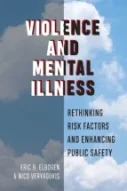Violence and Mental Illness Rethinking Risk Factors and Enhancing Public Safety
 Author: Eric B. Elbogen & Nico Verykoukis
Author: Eric B. Elbogen & Nico Verykoukis
Publisher: NYU Press, 2023. 208 pages.
Reviewer: Mia Thomaidou | April 2024
In their recent book Violence and Mental Illness, Professor Eric Elbogen and Nico Verykoukis address the problem of inflated public perceptions of a link between violence and mental illness. The book takes a precise, evidence-based approach to debunking popular misconceptions about violence among individuals with severe mental health conditions. The authors attempt to change the course of public dialogue regarding the risk factors and causes of violence by pointing out that the role of mental illness in violent acts is generally overstated due to exaggerated portrayals in the media as well as common cognitive biases. A central argument for caution is that, aside from the stigma and relevant negative consequences on individuals, blaming mental illness for violence can hinder the mitigation of violence by crowding out consideration of and interventions for more important risk factors. Throughout the book, the reader and the wider public are encouraged to adopt an alternative way of thinking about the causes of violent acts by relying on verifiable information regarding the true risk factors for violence.
Before delving into the relevant scientific research, four central ideas are put forward: for violence to occur, mental illness is neither 1) necessary nor 2) sufficient, 3) mental illness and violence are related, but the link is weaker than people think, and 4) ‘mental illness’ and ‘mental health issues’ are not the same. This fourth and final point is a critical pillar upon which the book’s argumentation and interpretation of the scientific literature depend. The authors concoct a differentiation between ‘mental health issues,’ those milder and more common problems that many people face at some point in their lives, and ‘serious mental illness,’ in which the authors include those severe innate disorders associated with dramatic cognitive-emotional disruptions, namely, psychosis, bipolar disorder, and major depression to the extent that involves severe cognitive distortions or psychotic symptoms. This differentiation is crucial, as the book goes on to provide evidence that the link between the three severe ‘mental illnesses’ and violence is weak while simultaneously showing that other ‘mental health issues,’ such as substance use and trauma-related disorders, are in fact among the more consistent predictors of violence.
In its endeavor to define severe mental illnesses, the book offers a comprehensive description of current understandings and definitions of mental disorders. Readers with and without a relevant science background benefit from a detailed explanation of disorders pertinent to the book’s arguments. Symptoms and behavioral profiles are provided alongside prevalence rates based on the Diagnostic and Statistical Manual for Mental Disorders (DSM-V). The authors observe that due to the powerful impact that serious mental illnesses have on behavior, they are often mistaken by the public as core explanatory variables when it comes to violent behavior.
In the first part of this book, the demonization of mental illness is traced through history, arriving at the present when, despite our better knowledge, those experiencing mental illness are still stigmatized and too often perceived as threatening and dangerous. Social dynamics, ‘othering,’ and unpredictability are identified as central reasons for people’s tendency to stigmatize mental illness. Popular media are also recognized as a shareholder of the blame for distorted perceptions of mental illness because of small and big screen characters’ inaccurate portrayals as well as the dehumanizing and unscientific labeling of mass shooters, extremists, and even war criminals as mentally ill.
The book provides a well-informed overview of a core cause of stigmatization: heuristics and cognitive biases–mental shortcuts and filters through which we perceive the world designed to compartmentalize and simplify things unfamiliar, complex, or incomprehensible. Our ‘fast-thinking’ cognitive systems are described as readily influenced by the salient memories of what is put forward in the media and the sensationalized reports of mental illness and its supposed involvement in crime and violence. The authors make a valid point that knee-jerk reactions and lack of informed thought play a significant role in public misperceptions of mental illness and its involvement in violence. However, cognitive biases are not necessarily counteracted by ‘slow thinking,’ nor has this been Daniel Kahneman’s position (Daniel Kahneman Explains The Machinery of Thought, 2023; Kahneman, 2011).
The core of this book lays out a skillfully thorough review of the literature on violence risk factors. The authors not only provide a detailed report on the scientific understanding of this issue but also delve deep into the methodology and quality of studies, a practice that attests to the detailed and meticulous work that shaped the substance of this book. The conclusions drawn from this literature review can be summarized succinctly: research can neither reliably show that the majority of people with mental illness commit violence nor that most violence perpetrated by people with mental illness. While the scientific literature does seem to face limitations that lead to inconsistent findings, this book skillfully synthesizes the most reliable slices of current knowledge. It concludes that the evidence is too weak to justify the stubborn public views of mental illness as a common cause of violence.
In presenting research findings on the involvement of mental illness in the many subcategories of violent behaviors and crimes, the authors are persistent in their intention to differentiate between severe mental illness with psychotic symptoms and all other mental disorders, as they choose to qualify disorders that are indeed linked to violence (such as trauma- or addiction-related conditions) as ‘other risk factors’, instead of mental illnesses. From this point, the authors arrive at a 3-category model showing that violence risk factors fall into three categories: 1) external, environmental risk factors such as lack of social structures, poverty, and trauma, 2) individual-level factors such as age, impulsivity, and substance abuse and 3) habituation and proximity to violence, with individuals being comfortable with the use of violence due to antisociality, believing that violence is an acceptable option, access to guns, or violent group affiliations. This latter category is described as necessary and sufficient for violence to occur, albeit the boundaries between the three categories are blurred, and it is unclear whether it is argued that individuals who are habituated to violence and see violence as an acceptable recourse or have access to firearms are indeed bound to engage in violence.
The authors also review relevant case studies. One prominent example is the case of Adam Lanza, the perpetrator of the 2012 Sandy Hook Elementary School shooting. Lanza had innate developmental disabilities, including verbal communication problems, sensory difficulties, socialization delays, and repetitive behaviors, as well as documented severe anxiety problems, deficiencies in empathy, and diagnoses of autism and obsessive-compulsive disorder (Associated Press, 2013). Many environmental factors aggravated his biological and behavioral mental health problems. Yet, the authors conclude that mental illness was not the driving factor of Lanza murdering twenty children and six adults. While it is reasonable to speculate that this tragedy could have been prevented had Lanza not had access to firearms, it is difficult to follow the authors’ argument that an array of bio-behavioral, neuro-developmental, and mental health problems were not at the center of Lanza’s behavior and/or should not be thought of as ‘mental illnesses.’ While Lanza’s case is by no means generalizable evidence that mental illness is linked to violence, it is a curious choice for supporting an argument to the contrary.
The book does not take a clear position on how the reader should think about violence within the full spectrum of neurobiological problems and mental health conditions. The central thesis and 3-category model proposed in this book, presented in table 6.1 as the 3-Category Violence Model seems to list several mental disorders and a variety of disorder symptoms among the ‘other factors’ that explain violence better than ‘mental illness’ does (e.g., Drug abuse, Antisocial personality disorder, Psychopathy, Posttraumatic anger, Violent victimization, Self-regulation problems, Violent fantasies.) One concern regarding this binary approach to defining mental illness in this context is that the public likely associates violence with the broader spectrum of mental disorders, including personality, alcohol use, and post-traumatic stress disorders, and not specifically with the three delineated severe mental illnesses.
In the latter part of the book, concrete, evidence-based suggestions are made for preventing violence by focusing on the three types of risk factors that were identified. Addressing neighborhood standards, housing conditions, occupational and financial well-being, social support, as well as behavioral interventions for parents and families are identified as promising avenues for reducing violence. The evidence reviewed indicates that some types of interventions that may intuitively seem impactful are not practically successful in reducing violence and crime. This highlights a major point of this book: our intuitions regarding cause and effect often need to be revised because relationships between factors and outcomes are more complex and nuanced than our logic can account for in the absence of concrete evidence. For readers with no background in science, the last three chapters also serve as a guide for understanding the limitations of study designs and what one should scrutinize before accepting a relationship–say, between mental illness and violence–as meaningful.
Overall, this book builds a skillful argument for developing and updating our understanding of the true causes of violence. At the same time, the authors provide clear and constructive alternatives to popular ways of thinking about the relevance of mental illness in violent acts. Still, in their constructed 3-category model, it becomes clear that the authors arrive at specific conclusions that depend on a narrow concept of mental illness, one that has redefined the spectrum of mental disorders by assigning a binary distinction between the most severe mental illnesses and all other mental health conditions including addiction, trauma, developmental disorders, and even paraphilia. At its core, the message of this book is evident in asserting that the public errs in believing that a specific set of severe mental illnesses is to blame for the majority of violent behavior. An extensive review of the literature shows that severe innate mental illness is only a “small piece of the puzzle of violence.” The book compiles evidence that paints a nuanced picture of violence and demonstrates that public perceptions do not match what high-quality empirical research shows: a combination of variables is to blame for violent acts, and severe innate mental illness is not the sole driving factor of violence.
References
Associated Press (2013, December 27). Newtown police file released. POLITICO. https://www.politico.com/story/2013/12/newtown-shooting-police-file-101561
Daniel Kahneman explains the machinery of thought. (2023). Farnam Street Media Inc. https://fs.blog/daniel-kahneman-the-two-systems/
Kahneman, D. (2011). Thinking, fast and slow (1st ed.). Farrar, Straus and Giroux.
Dr. Mia Thomaidou, Post-Doctoral Fellow, School of Criminal Justice, Rutgers University.


